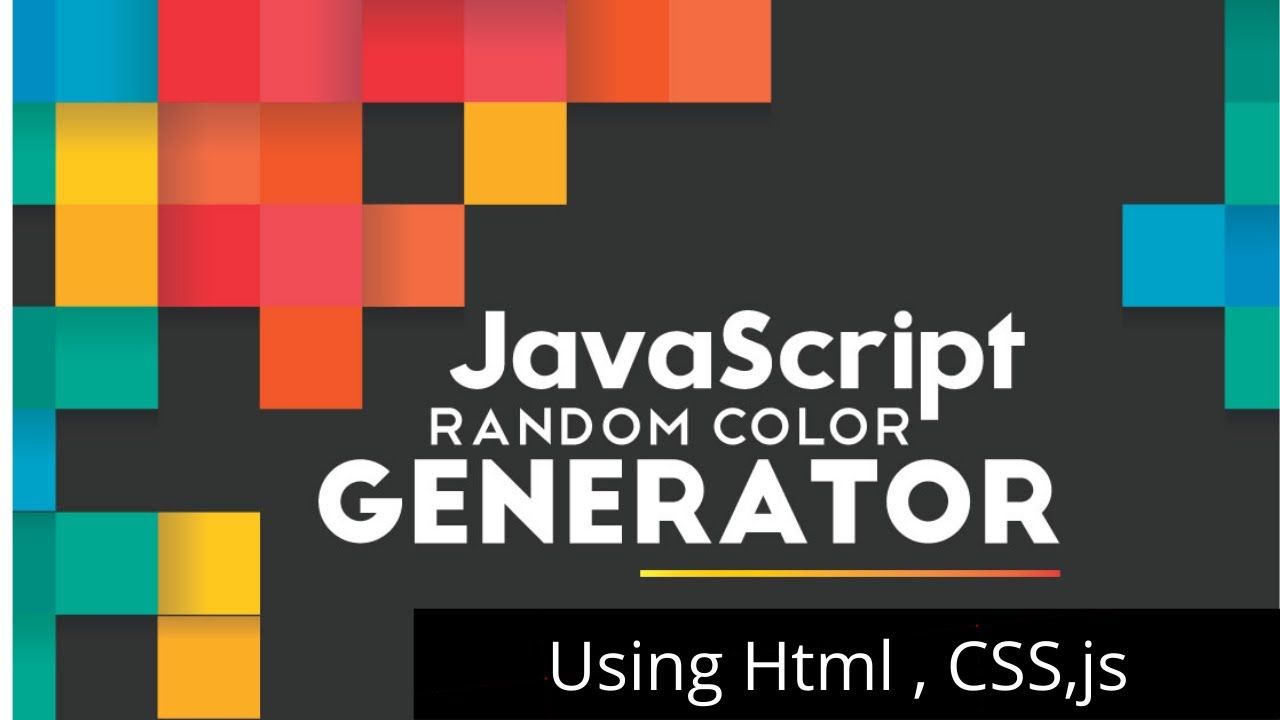Generating Random Colors in JavaScript: A Step-by-Step Guide
 Raaj Aryan
Raaj Aryan
Colors play a crucial role in web design, bringing vibrancy and personality to your applications. One interesting way to make your web applications more dynamic is by generating random colors. In this blog post, we'll explore different methods to generate random colors in JavaScript. Whether you need hexadecimal, RGB, HSL, or even CSS color names, you'll find a technique that suits your needs.
Why Generate Random Colors?
Random colors can be useful for various purposes:
Creating random backgrounds or themes
Assigning unique colors to different elements dynamically
Generating color palettes
Adding an interactive element to your web applications
Methods to Generate Random Colors
1. Hexadecimal Color
Hexadecimal colors are one of the most common formats used in web design. A hex color code is a six-digit code that represents a color.
Example
function getRandomHexColor() {
const letters = '0123456789ABCDEF';
let color = '#';
for (let i = 0; i < 6; i++) {
color += letters[Math.floor(Math.random() * 16)];
}
return color;
}
Usage
const randomHexColor = getRandomHexColor();
console.log(randomHexColor); // Example output: #3E2F1B
2. RGB Color
RGB (Red, Green, Blue) colors are represented by three numbers, each ranging from 0 to 255.
Example
function getRandomRGBColor() {
const r = Math.floor(Math.random() * 256);
const g = Math.floor(Math.random() * 256);
const b = Math.floor(Math.random() * 256);
return `rgb(${r}, ${g}, ${b})`;
}
Usage
const randomRGBColor = getRandomRGBColor();
console.log(randomRGBColor); // Example output: rgb(123, 45, 67)
3. HSL Color
HSL (Hue, Saturation, Lightness) colors are represented by three values. Hue ranges from 0 to 360, while saturation and lightness are percentages.
Example
function getRandomHSLColor() {
const h = Math.floor(Math.random() * 361); // 0 to 360
const s = Math.floor(Math.random() * 101); // 0% to 100%
const l = Math.floor(Math.random() * 101); // 0% to 100%
return `hsl(${h}, ${s}%, ${l}%)`;
}
Usage
const randomHSLColor = getRandomHSLColor();
console.log(randomHSLColor); // Example output: hsl(240, 100%, 50%)
4. CSS Color Names
CSS supports a predefined set of color names, which can be randomly selected.
Example
function getRandomCSSColor() {
const cssColors = ["AliceBlue", "AntiqueWhite", "Aqua", "Aquamarine", "Azure", "Beige", "Bisque", "Black", "BlanchedAlmond", "Blue", "BlueViolet", "Brown", "BurlyWood", "CadetBlue", "Chartreuse", "Chocolate", "Coral", "CornflowerBlue", "Cornsilk", "Crimson", "Cyan", "DarkBlue", "DarkCyan", "DarkGoldenRod", "DarkGray", "DarkGreen", "DarkKhaki", "DarkMagenta", "DarkOliveGreen", "DarkOrange", "DarkOrchid", "DarkRed", "DarkSalmon", "DarkSeaGreen", "DarkSlateBlue", "DarkSlateGray", "DarkTurquoise", "DarkViolet", "DeepPink", "DeepSkyBlue", "DimGray", "DodgerBlue", "FireBrick", "FloralWhite", "ForestGreen", "Fuchsia", "Gainsboro", "GhostWhite", "Gold", "GoldenRod", "Gray", "Green", "GreenYellow", "HoneyDew", "HotPink", "IndianRed", "Indigo", "Ivory", "Khaki", "Lavender", "LavenderBlush", "LawnGreen", "LemonChiffon", "LightBlue", "LightCoral", "LightCyan", "LightGoldenRodYellow", "LightGray", "LightGreen", "LightPink", "LightSalmon", "LightSeaGreen", "LightSkyBlue", "LightSlateGray", "LightSteelBlue", "LightYellow", "Lime", "LimeGreen", "Linen", "Magenta", "Maroon", "MediumAquaMarine", "MediumBlue", "MediumOrchid", "MediumPurple", "MediumSeaGreen", "MediumSlateBlue", "MediumSpringGreen", "MediumTurquoise", "MediumVioletRed", "MidnightBlue", "MintCream", "MistyRose", "Moccasin", "NavajoWhite", "Navy", "OldLace", "Olive", "OliveDrab", "Orange", "OrangeRed", "Orchid", "PaleGoldenRod", "PaleGreen", "PaleTurquoise", "PaleVioletRed", "PapayaWhip", "PeachPuff", "Peru", "Pink", "Plum", "PowderBlue", "Purple", "RebeccaPurple", "Red", "RosyBrown", "RoyalBlue", "SaddleBrown", "Salmon", "SandyBrown", "SeaGreen", "SeaShell", "Sienna", "Silver", "SkyBlue", "SlateBlue", "SlateGray", "Snow", "SpringGreen", "SteelBlue", "Tan", "Teal", "Thistle", "Tomato", "Turquoise", "Violet", "Wheat", "White", "WhiteSmoke", "Yellow", "YellowGreen"];
const randomIndex = Math.floor(Math.random() * cssColors.length);
return cssColors[randomIndex];
}
Usage
const randomCSSColor = getRandomCSSColor();
console.log(randomCSSColor); // Example output: Coral
5. Using Color Libraries
You can also use JavaScript libraries like chroma.js or tinycolor2 to generate random colors with more advanced features.
Example with TinyColor
First, include the TinyColor library in your project. You can install it via npm:
npm install tinycolor2
Or include it via a CDN in your HTML file:
<script src="https://cdnjs.cloudflare.com/ajax/libs/tinycolor/1.4.2/tinycolor.min.js"></script>
Then, you can generate random colors as follows:
function getRandomTinyColor() {
return tinycolor.random().toString();
}
Usage
const randomTinyColor = getRandomTinyColor();
console.log(randomTinyColor); // Example output: rgb(136, 45, 67)
Putting It All Together: A Simple Web Page Example
To illustrate how these functions can be used in a web page, here’s an example where clicking a button changes the background color of the page to a randomly generated color:
<!DOCTYPE html>
<html lang="en">
<head>
<meta charset="UTF-8">
<meta name="viewport" content="width=device-width, initial-scale=1.0">
<title>Random Color Generator</title>
<style>
#bgcolor {
height: 100vh;
width: 100%;
display: flex;
justify-content: center;
align-items: center;
}
button {
padding: 10px;
font-size: 16px;
cursor: pointer;
}
</style>
</head>
<body id="bgcolor">
<button>Click me</button>
<script>
const btn = document.querySelector('button');
const bgc = document.querySelector('#bgcolor');
btn.addEventListener('click', () => {
bgc.style.backgroundColor = getRandomHexColor();
});
function getRandomHexColor() {
const letters = '0123456789ABCDEF';
let color = '#';
for (let i = 0; i < 6; i++) {
color += letters[Math.floor(Math.random() * 16)];
}
return color;
}
</script>
</body>
</html>
Conclusion
Generating random colors in JavaScript is a simple yet powerful technique to enhance the visual appeal of your web applications. Whether you need hexadecimal, RGB, HSL, or CSS color names, there are multiple methods to choose from. Experiment with these methods to find the one that best suits your project's needs and add dynamic, colorful elements to your web applications. Happy coding!
Subscribe to my newsletter
Read articles from Raaj Aryan directly inside your inbox. Subscribe to the newsletter, and don't miss out.
Written by

Raaj Aryan
Raaj Aryan
MERN Stack Developer • Open Source Contributor • DSA With Java • Freelancer • Youtuber • Problem-solving •